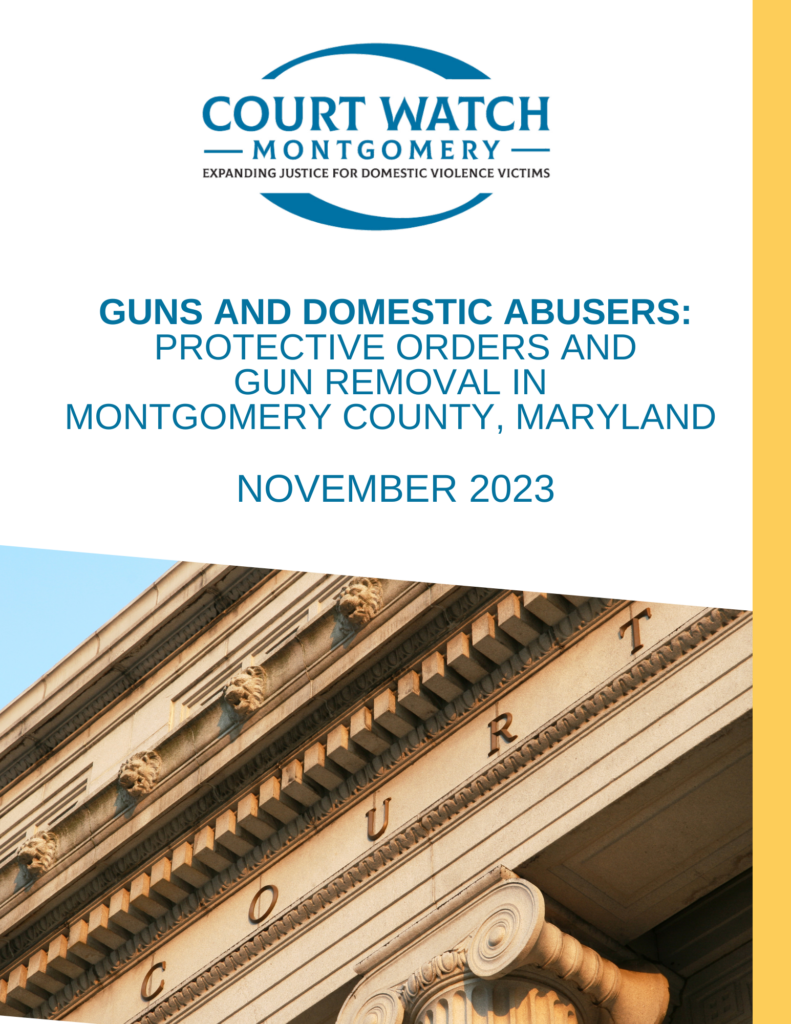Guns and Domestic Abusers: Protective Orders and Gun Removal in Montgomery County, Maryland

Recognizing the extreme danger of guns in domestic violence situations, and the risk to victim safety posed by the Rahimi case, we believe it is timely to report on relevant laws in Maryland and practices in Montgomery County to keep firearms away from domestic abusers through use of civil protective orders. Part I of this report presents an overview of federal and Maryland law governing domestic violence protective orders and firearms, followed by a description of the protective order process in Maryland and procedures used by the Montgomery County Sheriff’s Office to serve orders and remove guns. Data on the number of guns removed from abusers in Montgomery County also are presented. Part II of the report presents findings on the use of gun-related best practices by District Court judges at protective order hearings, based on data collected by Court Watch volunteers and our review of the protective order service process in Montgomery County. Conclusions and recommendations to address these findings are included at the end of the report.
2023 Staggered Exit Supplement: Montgomery County District Court Increased Use of Staggered Exits in Intimate Partner Violence Hearings from 2022 to 2023

Staggered exits are a nationally recognized best practice intended to keep victims safe, allowing them to leave the courtroom first after a protective order hearing, with their alleged offender leaving no sooner than 15 minutes thereafter. When properly executed, staggered exits reduce the risk of confrontation between the parties outside the courtroom and enable victims and their families to get safely to their transportation home. Staggered exits can help lessen trauma and increase the likelihood that victims will return to court when necessary to obtain a final order. Court Watch has seen the use of staggered exits fluctuate by year and vary by judge, despite the fact that they are cost-free and pose no significant burden to the courts. In our 2023 supplement, we are pleased to report that use of staggered exits in Montgomery County District Court increased by 20 percentage points in the one year since we last reported on use of this best practice. We applaud the judiciary’s commitment to use of this safe and free protocol.
2022 Yearly Report: Protective Order Outcomes

Civil protection orders are intended to protect victims of domestic violence by directing abusive partners to stop harming or threatening them and, in most cases, to stay away from them for the duration of the order. Protective orders are one of the most effective ways to stop or reduce domestic violence when paired with a strong safety plan and proper enforcement. Final protective orders have been shown to lower the risk of contact with abusers, decrease threats with a weapon and reduce injuries.
In this report, we provide the overall rates of final outcomes in protective order hearings observed by Court Watch in 2022: orders
granted, dismissed and denied. We then look at these rates by individual judge. We also examine how these outcomes are affected
by the presence of in-court support for victims from both victim advocates and attorneys. Finally, we analyze whether judges ask
petitioners certain safety-related questions or refer them to a victim advocate before agreeing to a request to dismiss their case.
Staggered Exit Report: Montgomery County District Courts Fail to Consistently Implement Recommended Safety Practice

Staggered exits are a nationally recognized best practice intended to keep victims safe, allowing them to leave the courtroom first after a protective order hearing, with their alleged offender leaving no sooner than 15 minutes thereafter. When properly executed, staggered exits reduce the risk of confrontation between the parties outside the courtroom and enable victims and their families to get safely to their transportation home. Staggered exits can help lessen trauma and increase the likelihood that victims will return to court when necessary to obtain a final order.
Court Watch has seen the use of staggered exits fluctuate by year and vary by judge, despite the fact that they are cost-free and pose no significant burden to the courts. As the courts emerge from Covid-related closures and parties return to in-person hearings, a renewed focus on staggered exits is timely. This report demonstrates that use of staggered exits in Montgomery County has continued to decline, even though the practice is recommended by the Maryland Judiciary and supported by the Montgomery Court District Courts.
COVID Impact Report: Intimate Partner Violence and the Montgomery County Courts during the COVID Pandemic

This report discusses some nationwide and local information on what is known about the impact of COVID on intimate partner violence (IPV). It then describes the experience of CWM in remotely monitoring IPV hearings in Montgomery County District Court, after COVID made in-person monitoring either impossible or highly challenging and presents limited findings from the data collected.
Snapshot of Domestic Violence Protective Orders in Montgomery County during COVID-19

This informational report provides a brief summary of the number of Protective Orders granted in 2019
and 2020 in Montgomery County, at the height of COVID-19. It demonstrates that during court closures,
while their numbers were much reduced, there were temporary, and some final protective orders
granted using both commissioners’ offices and virtual options. Additionally, during court disruptions,
data indicate that relief ordered was more restrictive than during normal court operations, presumably
due to judges giving priority to more dangerous cases.
Snapshot of Domestic Violence Protective Orders in Maryland during COVID-19

This informational report provides a brief summary of the number of Protective Orders granted in 2019
and 2020, at the height of COVID-19. It demonstrates that during court closures, while their numbers
were much reduced, there were temporary, and some final protective orders granted using both
commissioners’ offices and virtual options. To their credit, when courts re-opened with limited capacity
in June of 2020, they issued a typical pre-COVID number of final orders.
What does strangulation in Montgomery County look like? An analysis of strangulation in protective order hearings in Montgomery County, Maryland

In 2020 the Maryland General Assembly updgraded strangulation and intentional suffocation from a
second degree assault to first degree felony assault, indicating the seriousness of this crime. This report
discusses this complicated issue in inter partner violence cases, noting the difficulty of establishing
evidence of its occurrence. We examine the outcomes of 226 civil protective order cases in
Montgomery County between 2011 and 2019 where strangulation was alleged by the petitioner and
examine several variables, as well as reviewing the criminal and civil records of the abuser/respondents
to determine if they had prior records of inter partner violence.
Over 32,000 domestic violence 911 calls, but there’s still a lot we don’t know: An analysis of Montgomery County, Maryland 911 database

This report examines Montgomery County’s Data base of emergency police calls from 2017-2019 in an
effort to determine whether the 911 calls are appropriately flagged as inter partner violence related,
which would enable government and non-profit domestic violence agencies to identify areas in the
County where IPV is prevalent, establish the degree of violence, provide a baseline for studying trends.
The report finds the current 911 call coding system does not track the total number of emergency calls
related to IP, using non-specific codes that do not adequately describe the type of violence reported, as
well as discrepancies between what is reported by officers on the scene and the resultant coding.
An Update on Denied and Dismissed Protective Order in Montgomery County, Maryland

This report analyzes data collected by Court Watch Montgomery in 2,997 protective order hearings from 2015 to 2018 that resulted in judges granting final protective orders, denying the requests for protection, or victims dropping their cases. In it, we examine variables associated with dismissals and denials of petitions, possible gaps in court-based or community services as well as barriers to victims following through with the courts process. Key findings are that the percentage of protective orders granted dropped from 58% in 2015 to 42% in 2018, while dismissals increased from 32% in 2015 to 49% in 2018. Moreover, since 2015 dismissed petitions have consistently increased at the same time that the percentage of cases where judges utilized best practices aimed at keeping victims in the system decreased. In conclusion, the report reiterates that consistent implementation of best practices can help foster an increased faith in the court system and thereby increase the number of victims who take the courageous step of seeking legal protection.